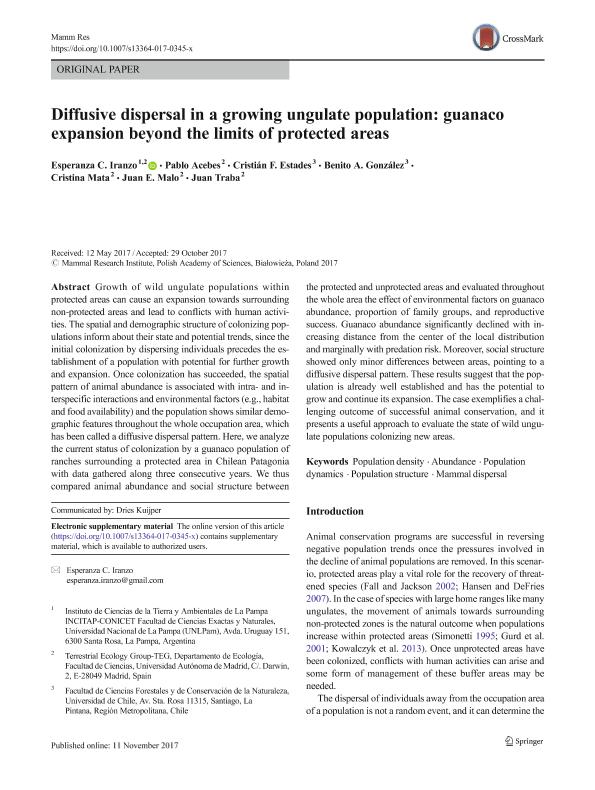Mostrar el registro sencillo del ítem
dc.contributor.author
Iranzo Sanz, Esperanza

dc.contributor.author
Acebes, Pablo
dc.contributor.author
Estades, Cristián F.
dc.contributor.author
González, Benito A.
dc.contributor.author
Mata, Cristina
dc.contributor.author
Malo, Juan E.
dc.contributor.author
Traba, Juan
dc.date.available
2019-08-12T19:00:20Z
dc.date.issued
2018-04
dc.identifier.citation
Iranzo Sanz, Esperanza; Acebes, Pablo; Estades, Cristián F.; González, Benito A.; Mata, Cristina; et al.; Diffusive dispersal in a growing ungulate population: guanaco expansion beyond the limits of protected areas; Springer Berlin Heidelberg; Mammal Research; 63; 2; 4-2018; 185-196
dc.identifier.issn
2199-241X
dc.identifier.uri
http://hdl.handle.net/11336/81492
dc.description.abstract
Growth of wild ungulate populations within protected areas can cause an expansion towards surrounding non-protected areas and lead to conflicts with human activities. The spatial and demographic structure of colonizing populations inform about their state and potential trends, since the initial colonization by dispersing individuals precedes the establishment of a population with potential for further growth and expansion. Once colonization has succeeded, the spatial pattern of animal abundance is associated with intra- and interspecific interactions and environmental factors (e.g., habitat and food availability) and the population shows similar demographic features throughout the whole occupation area, which has been called a diffusive dispersal pattern. Here, we analyze the current status of colonization by a guanaco population of ranches surrounding a protected area in Chilean Patagonia with data gathered along three consecutive years. We thus compared animal abundance and social structure between the protected and unprotected areas and evaluated throughout the whole area the effect of environmental factors on guanaco abundance, proportion of family groups, and reproductive success. Guanaco abundance significantly declined with increasing distance from the center of the local distribution and marginally with predation risk. Moreover, social structure showed only minor differences between areas, pointing to a diffusive dispersal pattern. These results suggest that the population is already well established and has the potential to grow and continue its expansion. The case exemplifies a challenging outcome of successful animal conservation, and it presents a useful approach to evaluate the state of wild ungulate populations colonizing new areas.
dc.format
application/pdf
dc.language.iso
eng
dc.publisher
Springer Berlin Heidelberg
dc.rights
info:eu-repo/semantics/openAccess
dc.rights.uri
https://creativecommons.org/licenses/by-nc-sa/2.5/ar/
dc.subject
Abundance
dc.subject
Mammal Dispersal
dc.subject
Population Density
dc.subject
Population Dynamics
dc.subject
Population Structure
dc.subject.classification
Ecología

dc.subject.classification
Ciencias Biológicas

dc.subject.classification
CIENCIAS NATURALES Y EXACTAS

dc.title
Diffusive dispersal in a growing ungulate population: guanaco expansion beyond the limits of protected areas
dc.type
info:eu-repo/semantics/article
dc.type
info:ar-repo/semantics/artículo
dc.type
info:eu-repo/semantics/publishedVersion
dc.date.updated
2019-08-09T14:33:36Z
dc.journal.volume
63
dc.journal.number
2
dc.journal.pagination
185-196
dc.journal.pais
Suiza

dc.description.fil
Fil: Iranzo Sanz, Esperanza. Consejo Nacional de Investigaciones Científicas y Técnicas. Instituto de Ciencias de la Tierra y Ambientales de La Pampa. Universidad Nacional de La Pampa. Facultad de Ciencias Exactas y Naturales. Instituto de Ciencias de la Tierra y Ambientales de La Pampa; Argentina. Universidad Autónoma de Madrid; España
dc.description.fil
Fil: Acebes, Pablo. Universidad Autónoma de Madrid; España
dc.description.fil
Fil: Estades, Cristián F.. Universidad de Chile; Chile
dc.description.fil
Fil: González, Benito A.. Universidad de Chile; Chile
dc.description.fil
Fil: Mata, Cristina. Universidad Autónoma de Madrid; España
dc.description.fil
Fil: Malo, Juan E.. Universidad Autónoma de Madrid; España
dc.description.fil
Fil: Traba, Juan. Universidad Autónoma de Madrid; España
dc.journal.title
Mammal Research
dc.relation.alternativeid
info:eu-repo/semantics/altIdentifier/doi/http://dx.doi.org/10.1007/s13364-017-0345-x
dc.relation.alternativeid
info:eu-repo/semantics/altIdentifier/url/https://link.springer.com/article/10.1007/s13364-017-0345-x
Archivos asociados
